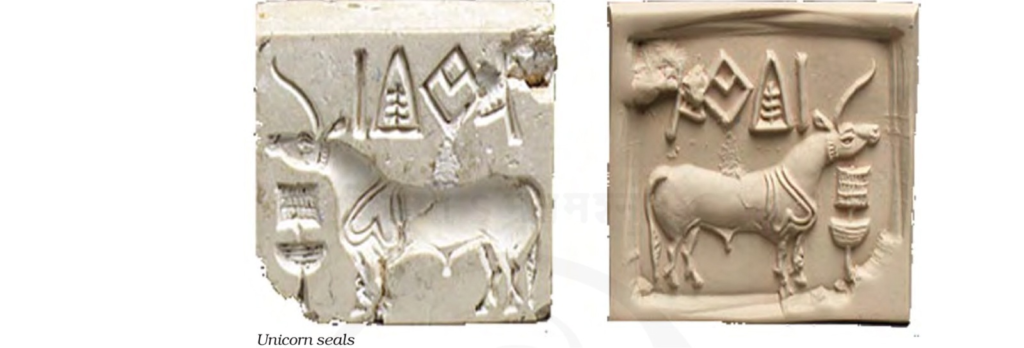Table of Contents
Indus Valley Sculpture
This article deals with topic titled ‘Indus Valley Sculpture .’ This is part of our series on ‘Culture’ . For more articles , you can click here
Introduction
- The artists of that time surely had fine artistic sensibilities and a vivid imagination.
- Art found at Indus valley include sculpture,seals,pottery,gold jewelry,terracotta figures
Stone Sculpture
Stone statuaries found at Harappa and Mohenjodaro are excellent examples of handling three- dimensional volumes.
1 . Bearded Priest
- Made up of Steatite
- It is interpreted as Priest or priest king
- Features

| Shawl | – Under right arm & covering left arm – Decorated with trefoil pattern (indicating embroidery was practiced commonly in Indus valley) |
| Eyes | Little elongated, and half-closed as in meditative concentration. |
| Nose | Well formed & medium sized |
| Mouth | Average sized |
| Moustache | Closed cut & short beard and whiskers |
| Ear | Resemble double shell |
| Armlet | On right hand & holes around neck indicating necklace |
2. Male torso

| Made of | Red Sandstone |
| Features | – Socket holes in neck & shoulders for attachment of head and arms – Shoulders well curbed & abdomen looks prominent – Balanced lines stand equal to beautiful art of Gandhara |
Bronze Casting
- Lost wax technique was used .
- In bronze we find human as well as animal figures, the best example being statue of a girl popularly titled ‘Dancing Girl’.
- Among animal figures in bronze buffalo with its uplifted head, back & sweeping horns and the goat are of artistic merit.

Terracotta
- The Indus Valley people made terracotta images also but compared to the stone and bronze statues the terracotta representations of human form are crude in the Indus Valley. They are more realistic in Gujarat sites and Kalibangan.
- The most important among the Indus figures are those representing the mother goddess. The repetition of this figure in exactly the same position would suggest that he was a deity.
- Toy carts with wheels, whistles, rattles, birds and animals, gamesmen and discs were also rendered in terracotta

Side Topic : Mother Goddess
- Necklace hanging over prominent breasts
- Most distinct feature- fan shaped head dress with cup like projection on each side
- Rest facial figures very crude & distant from being realistic
- Believed to be Goddess most probably linked to Fertility

Seals
- Archaeologists have discovered thousands of seals, usually made of steatite, and occasionally of agate, chert, copper, faience and terracotta, with beautiful figures of animals
- The purpose of producing seals was mainly commercial. It appears that the seals were also used as amulets, carried on the persons of their owners, perhaps as modern-day identity cards.
- The standard Harappan seal was a square plaque 2×2 square inches, usually made from the soft river stone, steatite
- Every seal is engraved in a pictographic script which is yet to be deciphered.
- They all bear a great variety of motifs, most often of animals including those of the bull, with or without the hump, the elephant, tiger, goat and also monsters. Sometimes trees or human figures were also depicted.

Side Topic : Pashupati Seal
- Most remarkable seal is Pashupati Seal.
- This seal depicts
- human figure seated cross-legged
- An elephant & a tiger are depicted to right side of seated figure, while on left a rhinoceros and a buffalo are seen.
- two antelopes are shown below the seat.

